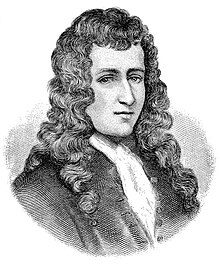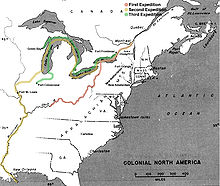Robert Cavelier de La Salle
René Robert Cavelier de La Salle (born November 22, 1643 in Rouen , † March 19, 1687 in what is now Texas ) was a French explorer.
Life
René Robert Cavelier was a son of the wealthy merchant Jean Cavelier in Rouen . The name "La Salle", which he later adopted, came from a family estate near Rouen. René Robert received his education at the Jesuit College of Rouen and entered the order as a novice.
However, in 1666, at the age of 22, he left the Jesuit order and traveled to the French colony of New France , later "Canada", in which his brother Jean was, a priest of the Sulpizian order . This order gave him a piece of land near Montréal . There he began to build a fortified settlement, worked in the fur trade and learned Indian languages . Under the impression of reports about a large river system, which was supposed to flow into the Gulf of California and thus open a connection to the Pacific and East Asia, he sold his possessions in 1669, the place got the nickname Lachine (China). He made his first research trip to the Ohio region. Historians now doubt whether he discovered the Ohio River , as was long believed . La Salle was assisted in his endeavors by Louis de Frontenac , the governor of Canada. The establishment of Fort Frontenac on Lake Ontario goes back to both . This fort not only served as a security against the hostile Indian tribe of the Iroquois , but was also intended to bring the fur trade between the Great Lakes and the English and Dutch settlements on the coast under French control. In doing so, La Salle and Frontenac turned the fur traders of Montréal against them, who feared for their business, and angered the Jesuits, who saw their influence on the Indians waning. In competition with the other colonial powers, La Salle pursued the strategy of taking possession of the interior for France and in this way preventing the enemy from expanding. Frontenac recommended La Salle to King Louis XIV of France as the man best qualified to carry out these large-scale plans and earned him a title of nobility.
In 1677 La Salle traveled to France and received the official commission from Louis XIV to explore the west of New France and to build as many forts there as he thought necessary. Despite the support of the Crown, La Salle received no money, which forced him to borrow large sums of money. In addition to his debts, the hostility of the Jesuits continued to cause him trouble. In 1678 La Salle returned to Canada. In 1679 he had the "Griffon" built on Lake Erie for commercial purposes. This first sailing ship on the Great Lakes was supposed to bring in the necessary funds for an expedition along the Mississippi , discovered by Louis Joliet and Jacques Marquette in 1673 . He had come to the conviction that the Mississippi did not flow into the Pacific but into the Gulf of Mexico , and planned to build a fortified port there, which was directed against the Spanish and English competition. In preparation he also learned survival techniques from the Indians, with the help of which he mastered dangerous situations on several occasions. His plans suffered severe setbacks with the shipwreck of the "Griffon" and in 1680 with a mutiny at Fort Crèvecœur on the Illinois River .
In the winter of 1682 he began a sledge expedition across the frozen Illinois River, reached the Mississippi, continued to sail it with canoes and on April 7, 1682 was the first European to reach its mouth. He and his expedition were probably the first to get from the Great Lakes to the Mississippi Estuary. On April 9th he solemnly took possession of all areas that touched the Mississippi for the French crown and named the territory in honor of King Louis XIV. "La Louisiane" ( Louisiana , today - much smaller than then - a federal state of United States). The following year, La Salle opened a branch on the Illinois River called Fort St. Louis. He looked in vain for help from Frontenac's successor in Québec. However, he did not carry out his order to give up the colony, but went to France to seek help from Louis XIV. The king supported him and ordered the governor to return all of La Salle's possessions.
With the help of the crown, La Salle organized an expedition in France with which he wanted to reach the mouth of the Mississippi by sea and set up a colony there. From there the colonies of Spain in Mexico and what is now Texas , with which France was at war, were to be attacked. From the beginning there were doubts about the feasibility of the plan, but Louis XIV supported it and provided ships. The expedition suffered from difficulties from the start. The relationship between La Salle and the captains under him was bad. A ship was lost to pirates in the Caribbean . Further difficulties arose from illnesses on board and navigation problems. The expedition missed the mouth of the Mississippi and landed on February 20, 1685 about 800 km away in Matagorda Bay in what is now Texas. La Salle had a fortified settlement called Fort St. Louis built for the 200 colonists. With the sinking of the flagship “L 'Aimable” and in 1686 the last remaining ship “ La Belle ”, important material and the connection to the outside world were lost. From Fort St. Louis, La Salle undertook two expeditions west and east to determine its location. On a third expedition with which he wanted to get help for the colony, he was murdered on March 19, 1687 by members of his expedition. The remaining 20 colonists were killed when Indians raided Fort St. Louis in the winter of 1688/1689. Some children were later freed by the Spanish.
Although La Salle was undoubtedly one of the most important pioneers of the French colonization of North America and had vision and foresight as well as the ability to proceed systematically and according to plan, he failed. In addition to accidents, his character deficits - he was accused of arrogance , impatience and lack of intuition in dealing with his subordinates - seem to have played a decisive role. His discoveries and travels were nevertheless of great importance as they set the lines of development for the French colonies in North America. Since Spain, under the influence of the French colony, has so far only claimed, but began to develop undeveloped areas in the west of today's Texas, La Salle's expedition indirectly brought about the creation of today's US state of Texas.
literature
- Urs Bitterli : The Discovery of America - From Columbus to Alexander von Humboldt . 2nd Edition. Munich 2006, ISBN 3-406-42122-9 , pp. 374-378 .
- Philip Marchand : Ghost Empire: How the French Almost Conquered North America . McClelland & Stewart, Toronto 2005 ISBN 978-0-7710-5677-2
- Hans-Otto Meissner : Louisiana for my king. The adventures of Robert La Salle . Cotta, Stuttgart 1966; again Klett, Stuttgart 1982, 3rd edition ISBN 3-12-920023-1
Web links
- La Salle at Virtual Museum of New France (Optional English, French), a site of Canada's National Museum of History and Society
- Online at Catholic Encyclopedia
Individual evidence
- ↑ so still Uwe Lübken: The nature of danger: floods on the Ohio River in the 19th and 20th centuries. V&R , Göttingen 2014, p. 49
- ↑ Urs Bitterli: The Discovery of America - From Columbus to Alexander von Humboldt . 2nd Edition. Munich 2006, ISBN 3-406-42122-9 , pp. 376 .
| personal data | |
|---|---|
| SURNAME | La Salle, Robert Cavelier de |
| ALTERNATIVE NAMES | Cavelier, René Robert de la Salle |
| BRIEF DESCRIPTION | French explorer |
| DATE OF BIRTH | November 22, 1643 |
| PLACE OF BIRTH | Rouen |
| DATE OF DEATH | March 19, 1687 |
| Place of death | Texas |



